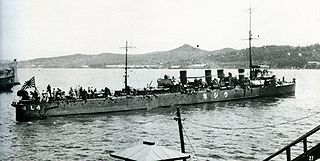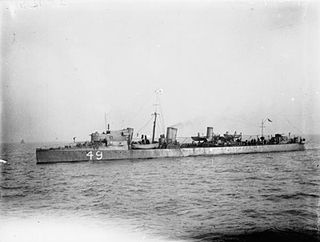
In naval terminology, a destroyer is a fast, maneuverable, long-endurance warship intended to escort larger vessels in a fleet, convoy, or carrier battle group and defend them against a wide range of general threats. They were originally conceived in 1885 by Fernando Villaamil for the Spanish Navy as a defense against torpedo boats, and by the time of the Russo-Japanese War in 1904, these "torpedo boat destroyers" (TBDs) were "large, swift, and powerfully armed torpedo boats designed to destroy other torpedo boats". Although the term "destroyer" had been used interchangeably with "TBD" and "torpedo boat destroyer" by navies since 1892, the term "torpedo boat destroyer" had been generally shortened to simply "destroyer" by nearly all navies by the First World War.

A torpedo boat is a relatively small and fast naval ship designed to carry torpedoes into battle. The first designs were steam-powered craft dedicated to ramming enemy ships with explosive spar torpedoes. Later evolutions launched variants of self-propelled Whitehead torpedoes.

A warship or combatant ship is a ship that is built and primarily intended for naval warfare. Usually they belong to the armed forces of a nation. As well as being armed, warships are designed to withstand damage and are typically faster and more maneuverable than merchant ships. Unlike a merchant ship, which carries cargo, a warship typically carries only weapons, ammunition and supplies for its crew. Warships usually belong to a navy, though they have also been operated by individuals, cooperatives and corporations.

The Havock class was a class of torpedo boat destroyer (TBD) of the British Royal Navy. The two ships, Havock and Hornet, built in London in 1893 by Yarrow & Company, were the first TBDs to be completed for the Royal Navy, although the equivalent pair from J.I. Thornycroft, Daring and Decoy, were ordered five days earlier.

In late 19th-century naval terminology, torpedo gunboats were a form of gunboat armed with torpedoes and designed for hunting and destroying smaller torpedo boats. By the end of the 1890s torpedo gunboats were superseded by their more successful contemporaries, the torpedo boat destroyers.
The Jeune École was a strategic naval concept developed during the 19th century. It advocated the use of small, heavily armed vessels to combat larger battleships, and the use of commerce raiders to cripple the trade of the rival nation. The idea was developed among French naval theorists: the French government had the second largest navy of the time, and the theorists desired to counteract the strength of the larger British Royal Navy.

Fernando Villaamil Fernández-Cueto was a Spanish naval officer, remembered for his internationally recognized professionalism, for being the inventor of the destroyer warship and for his death in action during the naval Battle of Santiago de Cuba of the Spanish–American War, being the highest ranking Spanish officer to suffer this fate in that conflict.

The Murakumo-class destroyers were a class of six torpedo boat destroyers (TBDs) of the Imperial Japanese Navy, built in Britain in 1897–99. The class is also sometimes referred to as the Shinonome-class destroyers("Daybreak"). All were named after celestial phenomena.

The Shirakumo-class destroyers was a class of two torpedo boat destroyers (TBDs) of the Imperial Japanese Navy, built in Britain in 1901–02.

Two Daring-class destroyers were the very first torpedo boat destroyers ("TBDs") to be ordered for the Royal Navy, the order being placed on 27 June 1892.

HMS Surly was a Rocket-class destroyer of the Royal Navy. She was launched at Clydebank in 1894, served in home waters and was sold in 1920.

Mykolaiv Shipyard was a major shipyard located in Mykolaiv, Ukraine. Originally named the Nikolayev Admiralty, and constructed in 1788 for the purpose of supplying the Russian Black Sea Fleet, the Mykolaiv Shipyard was famous for having built warships such as Vitse-admiral Popov, Knyaz' Potemkin-Tavricheskiy and Imperator Nikolai I for the Russian Empire, and Soobrazitelny, Gnevny, Nikolayev and Slava for the Soviet Union.

Furor was a Furor-class destroyer of the Spanish Navy that fought at the Battle of Santiago de Cuba during the Spanish–American War.

Terror was a Furor-class destroyer of the Spanish Navy that fought at San Juan, Puerto Rico during the Spanish–American War. Constructed in the United Kingdom, the ship entered service in 1896 and was significantly damaged at the Second Battle of San Juan in 1898. In 1920, the destroyer was converted to a minelayer and discarded in 1924.

The Kamikaze-class destroyers were a class of thirty-two torpedo boat destroyers (TBDs) of the Imperial Japanese Navy. The Kamikaze class of destroyers were the first destroyers to be mass-produced in Japan. The class is also sometimes referred to as the Asakaze class. This class of destroyer should not be confused with the later Kamikaze-class destroyers built in 1922, which participated in the Pacific War.

Teniente Serrano was a torpedo boat destroyer commissioned by the Chilean Navy in 1896. It was built by Laird Brothers along with three other destroyers: Capitán Orella, Capitán Muñoz Gamero and Guardiamarina Riquelme.

HMS Recruit was a Clydebank three-funnel, 30-knot destroyer ordered by the Royal Navy under the 1895–1896 Naval Estimates. She was the fifth ship to carry this name since it was introduced in 1806 for an 18-gun brig-sloop, sold in 1822.

HMS Kestrel was a Clydebank-built three funnelled 30-knot destroyer ordered by the Royal Navy under the 1895 – 1896 Naval Estimates. She was the fourth ship to carry this name since it was first used in 1846 for a brigantine.

A torpedo cruiser is a type of warship that is armed primarily with torpedoes. The major navies began building torpedo cruisers shortly after the invention of the locomotive Whitehead torpedo in the 1860s. The development of the torpedo gave rise to the Jeune École doctrine, which held that small warships armed with torpedoes could effectively and cheaply defeat much larger battleships. Torpedo cruisers fell out of favor in most of the great power navies in the 1890s, though many other navies continued to acquire them into the early 1900s.

The Furor class was a type of destroyers of the Spanish Navy, similar to the units of the A class, or 27 knotters, of the British Royal Navy. Commissioned in 1896 by the then Minister of the Navy Admiral Beranger after the success of the design by Fernando Villaamil of the warship Destructor, which had given name to a whole typology of vessels.




















